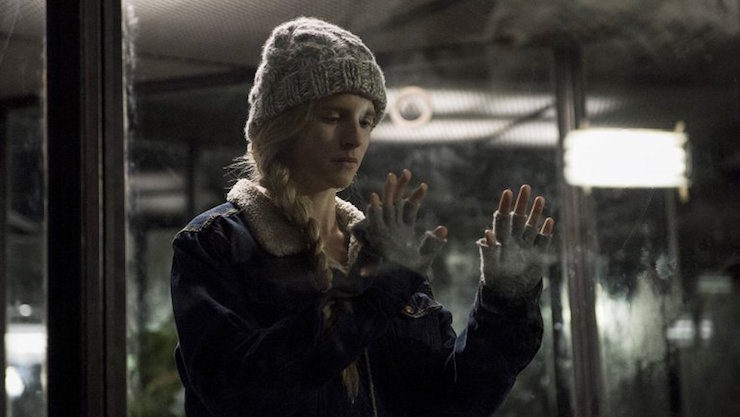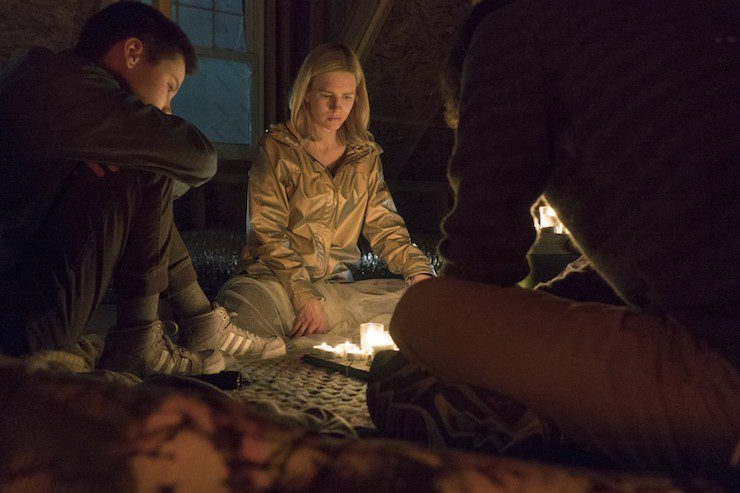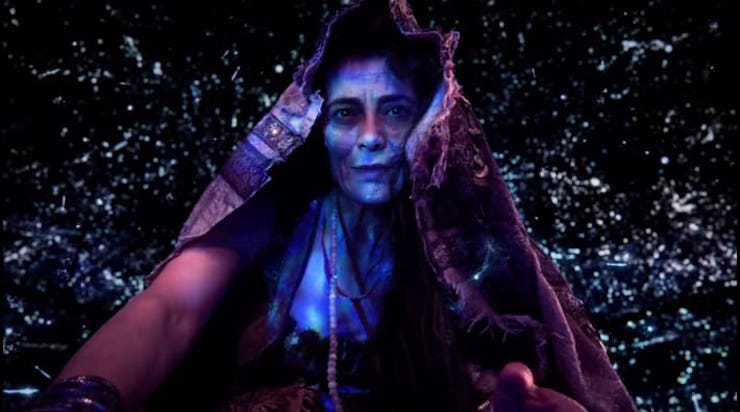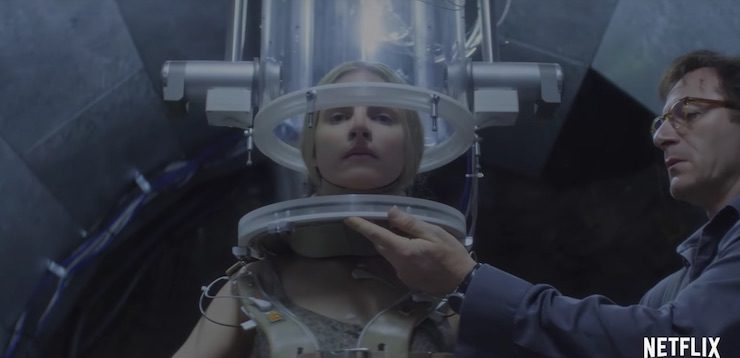In UFO Reality in 1983, British UFOlogist Jenny Randles coined the term ‘The Oz Factor’:
“…a sensation of being isolated, or transported from the real world into a different environmental framework…”
The Oz Factor was the first thing I thought of watching The OA, the first in a flotilla of vastly different and very good science fiction shows that arrived on Netflix just before Christmas. The OA is far and away the most obtuse of all of them but it’s also, I’d argue, the most rewarding.
Spoilers ahead.
The basic premise is this: Prairie Johnson disappeared just over seven years ago. She reappears on a busy road bridge, apparently out of nowhere, runs across traffic and then attempts to commit suicide by throwing herself off the bridge.
It doesn’t work. She’s reunited with her family. Except, when Prairie disappeared she was blind. Now, she can see.
As she struggles to adjust to life back in her hometown of Crestwood, we get hints of what Prairie went through. She searches obsessively for someone called ‘Homer’, barters with a local drug dealer for internet access, and eventually gathers a group of five people to her. They include the drug dealer, Steve (Patrick Gibson), his drifter friend Jesse (Brendan Meyer), over-achiever Alfonso ‘French’ Sosa (Brandon Perea), trans student Buck (Ian Alexander) and teacher Betty Broderick-Allen (Phyllis Smith). These people have, aside from Buck and Jesse’s patronage of Steve for steroids and weed respectively, nothing in common.
Aside from Prairie. And the story she tells them all.
Brit Marling, who co-created the show with frequent collaborator Zal Batmanglij, stars as Prairie and she acts as a kind of visual punctuation point for the show. Everyone else is refreshingly, untidily normal. Betty has given up caring about her job, Steve has embraced his family’s perception of him as a screw up, Jesse’s tragic home life is smothered under drugs. Even Ian and French, the show’s two most dynamic characters, are running in place.
Prairie, every time she’s on screen, gives the impression of incredible power barely held in check. Marling has staggering presence and it’s easy to see why Prairie draws people. Her impossible origin story that takes in a Russian childhood, organized crime, human trafficking and near death experiences, asks that anyone who listens to her story leave the door of their house. That image, and the power that resonates from it, is central to both her and the show. Prairie is an agent and embodiment of change, a woman who has not only returned different but isn’t planning on staying. Her story drives each one of her friends, the Crestwood Five, to look at how incomplete their lives are and to do something about it. It wakes them up, in a way that’s as profound as it is, at times, undeniably pretentious.
That story is the jewel in the crown of the series, a Donnie Darkonian structure that changes depending on how you approach the show. The idea is as good as it is nightmarish; Hap, played with straight-faced, terse calm by Jason Isaacs is a scientist convinced he can provide proof of life after death. Prairie, Homer (Emory Cohen), and their three compatriots are his press ganged explorers, murdered and revived over and over in the hopes of giving Hap what he needs; certainty about the uncertain.
The inherent contradiction in what Hap is trying to do is played with remarkable realism. He’s a high end prepper with a custom built lab who is so intent on discovering the truth he’s wilfully blinded himself to the horrors he’s perpetrating. The certainty he can’t find in his work he finds in his devotion to it and that gives the show many of its most terrifying moments. Homer’s repeated, gradual attempts to work out what Hap is doing to them are particularly terrifying as is the brief, shining moment Prairie escapes. Neither are allowed to continue. For Hap there’s only the work.
But for Prairie and her fellow prisoners there’s so much more. The show’s most ambitious, and controversial, element is the scenes Prairie shares with Khatun. Played by Palestinian actress and director Hiam Abbass, Khatun (a Mongolian term referring to the female equivalent of a Khan) is central to the show’s oddest elements. When we see her she’s in a space of indeterminate size, peppered with stars and pools. She pulls Prairie from one of these, twice, and each time gives her the option of remaining with Khatun or returning. In both cases, despite the horrors she’s told await her, Prairie opts to return.
This is mythological stuff, presented with the same straightforward style as the rest of the show. It’s also one of the axes of uncertainty The OA turns on. Taken at face value, its proof that everything Prairie is telling us is true and that the afterlife that Hap is desperate to prove the existence of is real. Viewed sceptically, it’s the first point where Prairie’s story becomes impossible.
The show’s second axis is also central to Khatun; the idea of the Five Movements. These are, as Hap describes them, ‘motion based technology’ but the reality is somewhere in the middle of a Venn diagram of martial arts kata, yoga movements, and a dance routine. The Movements, gifted to Prairie and her friends every time they remember an NDE and consume an animal they see there, are a means of escape. Once they have all five, they will be able to open a door to another dimension and flee Hap forever. Unless of course, Hap, who watches their every move, perfects the Movements first…
The Movements are where a lot of people fall off the show, and it’s easy to see why. A pivotal sequence sees Homer, who was used as bait to gain another prisoner for Hap, trying to reconcile with Prairie through the movements. The scene is fascinating and confounding, again, depending on where you stand. Looked at one way it’s a couple who have never been allowed to touch arguing through the nuance of motion. Looked at another way, its two people throwing shapes in an unusually disturbing church of science. The fact that the movements they use end up bringing a third captive back from the dead asks even more of the viewer.
But what carries you through is the sheer conviction that Marling and Cohen bring to the scene. The show even addresses natural scepticism over the Five Movements through both Steve in the present and the other captives in the past. The idea is ridiculous, but the idea is all they have and they believe in it so absolutely that, after a while, so do you. Prairie, and the show, pulls their audiences into a world where The Oz Factor is Queen through sheer conviction.
But the genius of The OA is what happens when you get there. As the show closes, both groups Prairie is part of have been changed forever. The prisoners are a close knit family unit and the Crestwood Five have found what their lives were missing in each other. There’s a cascade of scenes in the finale that show this; Prairie being torn out of her adoptive family’s grasp and left by the roadside en route to the first time we see her, Betty becoming Steve’s literal and metaphorical guardian and Buck becoming accepted for who he is are all particular standouts. They also all serve to push both groups of characters to re-cohere without Prairie. The storyteller is now outside the story.
Which, as the ending shows, may be exactly where she wants to be.
The finale is where the Oz Factor really takes hold. In short order, the Crestwood Five discover books at Prairie’s house that suggest she’s been making the whole thing up, French has a very odd conversation with Prairie’s FBI therapist and something impossible happens to a mirror. Perhaps.
Then, a man with a gun walks into their school.
This is the moment the series has been building towards and, like the rest of the show, it changes depending on what perspective you take. The Crestwood Five confront the shooter and use the movements to stop him. Or, the Crestwood Five confront the shooter and use the movements to distract him long enough so a staff member can tackle him. Or, the Crestwood Five use the movements to drive the shooter to send a single bullet directly into Prairie’s chest, sending her on her way to the dimension Homer has fled to.
There is evidence for all these things. Just as there’s evidence for Prairie being delusional, for a larger far more sinister agenda being at work or, perhaps, for the whole thing being a shadowplay carried out by the prisoners, in new bodies, one dimension over from the events depicted in the flashbacks. The moment where French looks in the mirror and sees Homer is right up there with the closing scene of Twin Peaks for disturbing imagery and the show wilfully refuses to give you answers as to why it’s there. The Oz Factor doesn’t allow for certainty. Just the sense of something impossible happening, or brushing past you on an empty street.
That’s why The OA is the most powerful thing you’ll see on Netflix. Or the least successful. Poignant, pretentious, clever or dull, the show and the truth it orbits changes depending on where you stand. Which, given the Five Movements, seems eminently appropriate.
Alasdair Stuart is a freelancer writer, RPG writer and podcaster. He owns Escape Artists, who publish the short fiction podcasts Escape Pod, Pseudopod, Podcastle, Cast of Wonders, and the magazine Mothership Zeta. He blogs enthusiastically about pop culture, cooking and exercise at Alasdairstuart.com, and tweets @AlasdairStuart.













